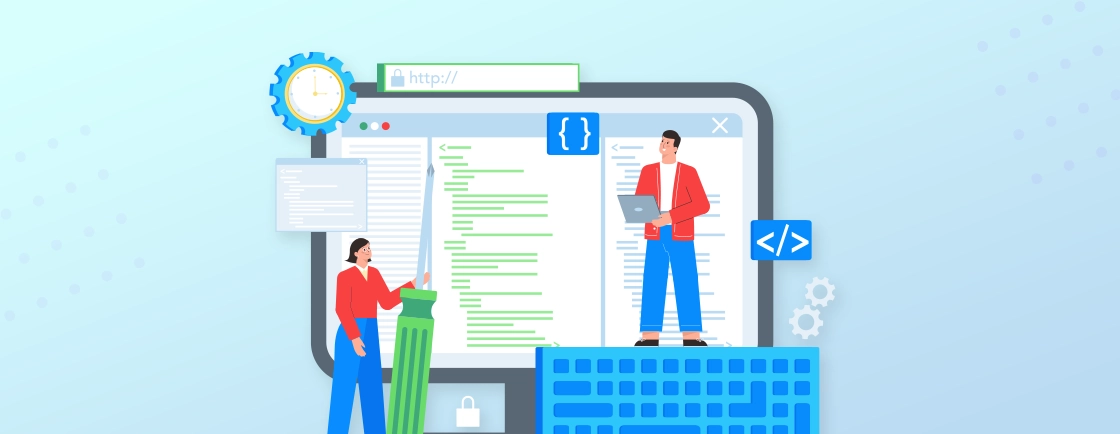Table of Contents
According to the latest statistics, people spend around 7 hours on the internet browsing through their favorite websites and other avenues. So the first thing to get the most eyes on your business or speciality is by creating a website. From just an informative website to a sleek online store, web development can help take your offerings far and wide.
Web development involves everything from crafting the visual appeal and user experience (UX) to writing the code that makes it all tick. That means a blend of creativity, technical expertise, and user focus.
In this blog, I’ll tell you all about the key elements of web development services. But first, let’s look at what web development means.
What is Web Development?
Web development is the process of creating, designing, and maintaining websites and web applications. The web development process includes planning, design, development, testing, launch, and maintenance. It is crucial to follow web security practices and use proper methodology for efficient and effective development.
It involves collaboration among various roles, including developers, designers, and content creators, to create effective websites. With that, now let’s explore the types of web development.
Types of Web Development
There are three specializations for web development namely: Frontend, backend and full-stack development. Each type plays a critical role in building and maintaining websites. Frontend development is for creating the user interface and backend development is to build the server side logic of a website.
Then there’s the full-stack development. It’s the combination of frontend development and backend development. Here is breakdown of each aspect of web development:
Frontend Development
Frontend development focuses on the visual and interactive aspects of a website. It involves coding the layout, design, and user interface. It can be done using web development languages like HTML, CSS, and JavaScript. Frontend developers ensure websites are visually appealing, user-friendly, and responsive across different devices and browsers.
They work on optimizing performance and implementing interactive features to enhance user experience. Tools like Angular, React, and Vue are commonly used to build dynamic and efficient websites.
When it comes to frontend, developers work on optimizing site performance to enhance user experience. Plus, it requires an understanding of design principles and accessibility standards.
Backend Development
Backend development involves creating server-side logic, databases, and APIs of a website. The backend server-side programming languages include, Python, Ruby, PHP and more. To make the development efficient, you can choose frameworks that fit your project.
It also includes site performance optimization, security measures, and integration with APIs. Using backend technologies like Django, Node.js, and more, you can ensure effective development. A good understanding of databases (SQL and NoSQL) and RESTful APIs is essential for backend developers.
Full-stack Development
Full-stack development is a combination of frontend and backend development. It allows a developer to handle the entire web development process. Full-stack developers are proficient in both client-side and server-side technologies. That enables them to build complete web applications from start to finish.
When it comes to full-stack development, the developers are aware of the best tech stacks and use them to take care of UI/UX as well as the server-side functionalities.
By combining the power of these three pillars, you can create a website that is dynamic and beautiful. Our web development experts are proficient in all three of these specializations. So you will get the best websites and web apps.
Top Web Development Languages
There are various web development languages available for different types of projects. Here are the top five languages for web development specifically:
- HTML5: HTML (HyperText Markup Language) structures web content. It’s the foundation of web pages, defining elements like headings, links, and images. HTML5, the latest version, adds multimedia support and improved performance for modern web applications.
- JavaScript: JavaScript is a dynamic scripting language for creating interactive web content. Running in browsers, it handles real-time updates, animations, and user input. Essential for frontend development, it’s also used on the server side with Node.js framework for full-stack applications.
- PHP: PHP (Hypertext Preprocessor) is a server-side scripting language embedded in HTML. It is ideal for dynamic web pages and applications. This interacts with databases and powers popular CMS like WordPress and Drupal, offering robust and scalable web solutions.
- Python: Python is a high-level, interpreted language known for readability and simplicity. Widely used in web development with frameworks like Django and Flask. It excels in rapid development, scalability, and integration with various python libraries and other tools.
- Java: Java is a robust, object-oriented programming language for building scalable, secure websites. Running on the Java Virtual Machine (JVM), it ensures cross-platform compatibility. Java is popular in enterprise environments, utilizing frameworks like Spring and Hibernate.
These are just a few of the many languages used in web development. The best language for a particular project will depend on your requirements and preferences.
Top Web Development Tools
Web development tools are software that help developers in creating, debugging, and maintaining websites. These tools streamline the development process, enhance productivity, and improve the performance of websites. Some common types of web development tools include:
- Code Editors and IDEs: Integrated Development Environment (IDE) are specialized text editors designed for writing code. They provide features like auto-completion and debugging tools to make coding efficient. Popular IDE options include Visual Studio Code, Sublime Text, and Atom.
- Browser Developer Tools: Browsers for developers like Chrome, Firefox, and Brave come with built-in developer tools. It allows developers to inspect the code, network requests, and performance of a web page. They are essential for debugging errors, optimizing sites, and ensuring responsiveness across different devices.
- Version Control Systems (VCS): These tools let developers track changes to code, collaborate, and revert to previous versions if necessary. Version control systems like Git are crucial for managing complex projects efficiently.
- Preprocessors and Frameworks: These tools simplify and enhance the coding process. Preprocessors like Sass or Less can extend CSS functionality. On the other hand, frameworks like React or Angular with built-in components streamline frontend development.
- Testing Tools: There are various tools for testing different aspects of a website, including functionality and security. These tools help identify and fix bugs before a website goes live.
Choosing the right web development tools depends on your specific needs and preferences. Many tools are free and open-source, reducing website maintenance costs. With that, let’s dive into web development technologies.
What are Web Development Technologies?
Web development technologies are used to create websites. You can split these technologies into two main categories: frontend and backend. Frontend technologies create the UI/UX of a website or web application. The backend technologies power the server-side functionality.
These technologies include server-side languages, databases, and application frameworks. Server-side scripting languages create dynamic web pages, and databases store and manage data. Plus, the frameworks provide a structure for developing and deploying web applications.
There are different types of web development technologies for building various functionalities on a website. Let’s see them in the next section.
Types of Web Development Technologies
Web development technologies are broadly divided into two basic types: frontend and backend. But when closely dissected, there are several types of technologies. It includes frameworks, CMS, eCommerce, and mobile development technologies. Here is a description of each of them.
Frameworks for Web Development
Frameworks are pre-written libraries of code that increase the efficiency of web development. They can streamline development by offering various features, pre-built components, and functionalities. Here are some of the most popular web frameworks:
- React: A powerful and versatile JavaScript library for building user interfaces. It’s known for its component-based architecture and virtual DOM, making it efficient for building complex and dynamic web applications.
- Angular: A comprehensive framework by Google for building web applications. It offers a range of features and tools, including routing and two-way data binding.
- Django: A high-level Python framework that follows the Model-View-Template (MVT) architectural pattern. It’s known for its rapid development capabilities and clean syntax.
- Express.js: A flexible Node.js framework for building web applications and APIs. It provides a lightweight foundation for developers to build custom web servers.
These frameworks offer an efficient way to build web applications by providing pre-built functionalities. They can be especially helpful for complex projects or those requiring consistent design patterns. To leverage frameworks for building your site efficiently, consider getting help from a framework development company.
Content Management Systems (CMS)
A Content Management System (CMS) is a tool that allows users to create, edit, and manage website content. They provide a user-friendly interface for managing text, images, videos, and other website elements. Here are some best CMS tools:
- WordPress: Often regarded as the best CMS, WordPress powers millions of websites worldwide. It’s known for its ease of use, extensive plugin library, and range of themes.
- Joomla: Another open-source CMS offering a user-friendly interface and a wide range of extensions for adding functionalities.
- Drupal: An open-source CMS known for its flexibility, scalability, and security features. It’s a powerful option for complex websites with demanding requirements.
- Shopify: It is a SaaS eCommerce platform that allows businesses of all sizes to create and manage their own online stores.
A CMS is a great option for non-technical users who need to manage website content without coding. It allows for easy updates and content creation, making it suitable for sites ranging from blogs to eCommerce.
eCommerce Development Technologies
eCommerce development technologies are the platforms used to create online stores. These platforms allow businesses to sell products and services online, manage inventory, process payments, and fulfill orders. Important features for an eCommerce site include:
- Online Store Creation: Ability to create and customize online stores with product listings, categories, and pricing.
- Payment Gateway Integration: Integration with secure payment gateways to accept online payments from customers.
- Shopping Cart Functionality: The shopping cart feature for customers to add and manage items before checkout.
- Order Management: Tools to manage orders, track shipments, and handle returns and refunds.
- Inventory Management: Ability to track and manage inventory levels, automate stock updates, and set alerts for low stock.
- Product Management: Tools for adding, editing, and organizing product information, including images, descriptions, and pricing.
- Analytics and Reporting: Tools for tracking sales, analyzing customer behavior, and generating reports to make informed business decisions.
These features are essential for creating an eCommerce website that meets the needs of businesses and customers.
Web technologies offer solutions for building a web presence at every stage. From frameworks to CMS, that enhances the efficiency of the site building process. If you want to develop a site using the above technologies, hire dedicated developers. They can offer you the best solutions with their knowledge of web development tech stack.
Conclusion
Web development is the backbone of the digital websites we interact with. The process is not simple, but with the right tools, languages, and technologies, it could be smooth and efficient. By leveraging various technologies, developers can build sites ranging from blogs to eStores.
The key languages for development include HTML, JavaScript, Python, and more. By learning them, you can leverage them as well as their frameworks effectively. If you are building a dynamic site, you also need a strong hand in database languages like SQL and NoSQL.
To get a beautiful and robust site developed, hire web developers. With their expertise in CMS, various languages, and experience can build a site that fits your vision.
FAQs on What is Web Development
What are the popular web development frameworks?
Some popular web development frameworks include Ruby on Rails, AngularJS, Django, and Laravel. These frameworks provide developers with pre-built components and tools to streamline the web development process.
Is web development hard to learn?
Web development can have a learning curve, but there are resources available for all skill levels. With dedication and practice, anyone can learn the fundamentals of web development.
How can I start learning web development?
To start learning web development, you can begin by learning the basics of HTML, CSS, and JavaScript. There are many online resources, tutorials, and courses available for beginners. As you progress, you can explore topics like backend development, frameworks, and databases to become a proficient web developer.
Explore Our Expert Guides
Dive into detailed tutorials, tips, and strategies designed to help you grow, innovate, and solve problems efficiently.





